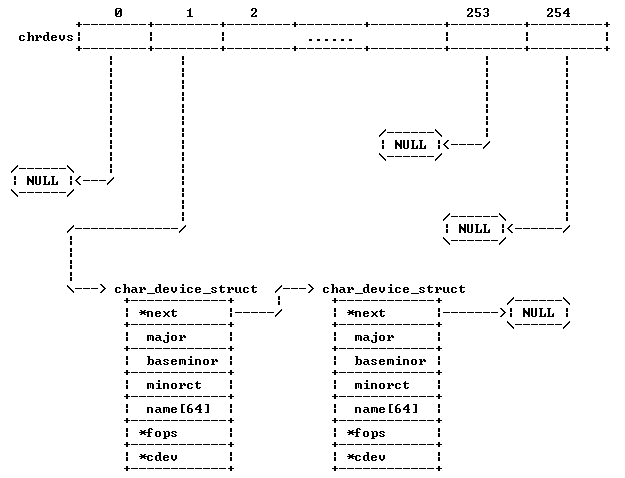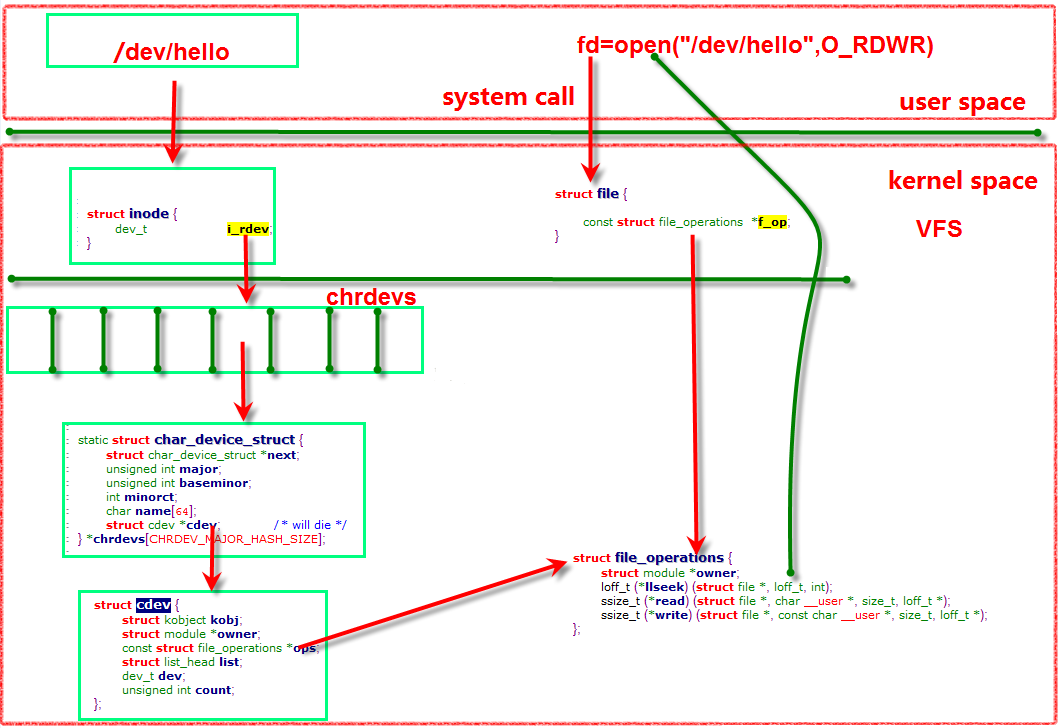强力推荐:
https://www.cnblogs.com/chen-farsight/p/6155518.html
https://www.cnblogs.com/chen-farsight/p/6177870.html
一:struct cdev
在Linux内核中,使用cdev结构体来描述一个字符设备,cdev结构体的定义如下:
struct cdev {
struct kobject kobj;
struct module *owner;
const struct file_operations *ops;
struct list_head list;
dev_t dev;
unsigned int count;
} __randomize_layout;二:struct file_operations
file_operations是一个函数指针集合的结构体,用于存放我们定义的用于操作设备的函数的指针,如果我们不定义,它默认保留为NULL。
内核源码中文件操作结构体的定义:
struct file_operations {
struct module *owner;
loff_t (*llseek) (struct file *, loff_t, int);
ssize_t (*read) (struct file *, char __user *, size_t, loff_t *);
ssize_t (*write) (struct file *, const char __user *, size_t, loff_t *);
ssize_t (*read_iter) (struct kiocb *, struct iov_iter *);
ssize_t (*write_iter) (struct kiocb *, struct iov_iter *);
int (*iterate) (struct file *, struct dir_context *);
int (*iterate_shared) (struct file *, struct dir_context *);
unsigned int (*poll) (struct file *, struct poll_table_struct *);
long (*unlocked_ioctl) (struct file *, unsigned int, unsigned long);
long (*compat_ioctl) (struct file *, unsigned int, unsigned long);
int (*mmap) (struct file *, struct vm_area_struct *);
unsigned long mmap_supported_flags;
int (*open) (struct inode *, struct file *);
int (*flush) (struct file *, fl_owner_t id);
int (*release) (struct inode *, struct file *);
int (*fsync) (struct file *, loff_t, loff_t, int datasync);
int (*fasync) (int, struct file *, int);
int (*lock) (struct file *, int, struct file_lock *);
ssize_t (*sendpage) (struct file *, struct page *, int, size_t, loff_t *, int);
unsigned long (*get_unmapped_area)(struct file *, unsigned long, unsigned long, unsigned long, unsigned long);
int (*check_flags)(int);
int (*flock) (struct file *, int, struct file_lock *);
ssize_t (*splice_write)(struct pipe_inode_info *, struct file *, loff_t *, size_t, unsigned int);
ssize_t (*splice_read)(struct file *, loff_t *, struct pipe_inode_info *, size_t, unsigned int);
int (*setlease)(struct file *, long, struct file_lock **, void **);
long (*fallocate)(struct file *file, int mode, loff_t offset,
loff_t len);
void (*show_fdinfo)(struct seq_file *m, struct file *f);
#ifndef CONFIG_MMU
unsigned (*mmap_capabilities)(struct file *);
#endif
ssize_t (*copy_file_range)(struct file *, loff_t, struct file *,
loff_t, size_t, unsigned int);
int (*clone_file_range)(struct file *, loff_t, struct file *, loff_t,
u64);
ssize_t (*dedupe_file_range)(struct file *, u64, u64, struct file *,
u64);
} __randomize_layout;
三:struct file
在设备驱动中,file是个非常重要的数据结构,必须要注意一点,这里的file与用户空间程序中的FILE指针是不同的,用户空间FILE是定义在C库中,从来不会出现在内核中。而struct file,却是内核当中的数据结构,因此,它也不会出现在用户层程序中。
file结构体指示一个已经打开的文件(设备对应于设备文件),其实系统中的每个打开的文件在内核空间都有一个相应的struct file结构体,它由内核在打开文件时创建,并传递给在文件上进行操作的任何函数,直至文件被关闭。如果文件被关闭,内核就会释放相应的数据结构。
在内核源码中,struct file要么表示为file,或者为filp(意指“file pointer”), 注意区分一点,file指的是struct file本身,而filp是指向这个结构体的指针。
描述进程中打开的文件,进程中只要调用了open就有一个该对象。具体描述了打开文件的路径,权限,标志,内部偏移等。file结构体是用来维护打开的文件的,每打开一次文件,内核空间里就会多增加一个file来维护,当文件关闭时释放。所以,在内核中同一个文件可以同时存在多个file结构体。
struct file {
union {
struct llist_node fu_llist;
struct rcu_head fu_rcuhead;
} f_u;
struct path f_path;
struct inode *f_inode; /* cached value */
const struct file_operations *f_op;
/*
* Protects f_ep_links, f_flags.
* Must not be taken from IRQ context.
*/
spinlock_t f_lock;
enum rw_hint f_write_hint;
atomic_long_t f_count;
unsigned int f_flags;
fmode_t f_mode;
struct mutex f_pos_lock;
loff_t f_pos;
struct fown_struct f_owner;
const struct cred *f_cred;
struct file_ra_state f_ra;
u64 f_version;
#ifdef CONFIG_SECURITY
void *f_security;
#endif
/* needed for tty driver, and maybe others */
void *private_data;
#ifdef CONFIG_EPOLL
/* Used by fs/eventpoll.c to link all the hooks to this file */
struct list_head f_ep_links;
struct list_head f_tfile_llink;
#endif /* #ifdef CONFIG_EPOLL */
struct address_space *f_mapping;
errseq_t f_wb_err;
} __randomize_layout
在struct file中有几个重要的成员:
1. loff_t f_pos;
这是用来记录文件的偏移量。在应用程序中,打开文件时偏移量为0,每次的读写操作都会使偏移量增加。
从这个原因可以看出为什么每打开一次文件就新建一个file结构体了。不然的话,每个打开文件的读写操作都修改同一个偏移量,那读写岂不是乱套了?
2. void *private_data;
这是空类型的指针可以用于存放任何数据,一般用这个指针来存放待会要定义的结构体指针。
回想一下,文件操作结构体fops中所有的函数成员里面都有一个参数是file结构体,所以每个函数都可以在file->private_data中拿到自己定义的结构体了。
3. struct file_operations *fops;
打开文件后,内核会把fops存放在这里,以后的操作就在这里在这里找函数了。
四:struct inode
VFS inode 包含文件访问权限、属主、组、大小、生成时间、访问时间、最后修改时间等信息。它是Linux 管理文件系统的最基本单位,也是文件系统连接任何子目录、文件的桥梁。
内核使用inode结构体在内核内部表示一个文件。因此,它与表示一个已经打开的文件描述符的结构体(即file 文件结构)是不同的,我们可以使用多个file 文件结构表示同一个文件的多个文件描述符,但此时,所有的这些file文件结构全部都必须只能指向一个inode结构体。
inode结构体包含了一大堆文件相关的信息,但是就针对驱动代码来说,我们只要关心其中的两个域即可:
-
dev_t i_rdev; 表示设备文件的设备号
-
struct cdev *i_cdev; struct cdev是内核的一个内部结构,它是用来表示字符设备的,当inode结点指向一个字符设备文件时,此域为一个指向cdev结构的指针。
/*
* Keep mostly read-only and often accessed (especially for
* the RCU path lookup and 'stat' data) fields at the beginning
* of the 'struct inode'
*/
struct inode {
umode_t i_mode;
unsigned short i_opflags;
kuid_t i_uid;
kgid_t i_gid;
unsigned int i_flags;
#ifdef CONFIG_FS_POSIX_ACL
struct posix_acl *i_acl;
struct posix_acl *i_default_acl;
#endif
const struct inode_operations *i_op;
struct super_block *i_sb;
struct address_space *i_mapping;
#ifdef CONFIG_SECURITY
void *i_security;
#endif
/* Stat data, not accessed from path walking */
unsigned long i_ino;
/*
* Filesystems may only read i_nlink directly. They shall use the
* following functions for modification:
*
* (set|clear|inc|drop)_nlink
* inode_(inc|dec)_link_count
*/
union {
const unsigned int i_nlink;
unsigned int __i_nlink;
};
dev_t i_rdev;
loff_t i_size;
struct timespec i_atime;
struct timespec i_mtime;
struct timespec i_ctime;
spinlock_t i_lock; /* i_blocks, i_bytes, maybe i_size */
unsigned short i_bytes;
unsigned int i_blkbits;
enum rw_hint i_write_hint;
blkcnt_t i_blocks;
#ifdef __NEED_I_SIZE_ORDERED
seqcount_t i_size_seqcount;
#endif
/* Misc */
unsigned long i_state;
struct rw_semaphore i_rwsem;
unsigned long dirtied_when; /* jiffies of first dirtying */
unsigned long dirtied_time_when;
struct hlist_node i_hash;
struct list_head i_io_list; /* backing dev IO list */
#ifdef CONFIG_CGROUP_WRITEBACK
struct bdi_writeback *i_wb; /* the associated cgroup wb */
/* foreign inode detection, see wbc_detach_inode() */
int i_wb_frn_winner;
u16 i_wb_frn_avg_time;
u16 i_wb_frn_history;
#endif
struct list_head i_lru; /* inode LRU list */
struct list_head i_sb_list;
struct list_head i_wb_list; /* backing dev writeback list */
union {
struct hlist_head i_dentry;
struct rcu_head i_rcu;
};
u64 i_version;
atomic_t i_count;
atomic_t i_dio_count;
atomic_t i_writecount;
#ifdef CONFIG_IMA
atomic_t i_readcount; /* struct files open RO */
#endif
const struct file_operations *i_fop; /* former ->i_op->default_file_ops */
struct file_lock_context *i_flctx;
struct address_space i_data;
struct list_head i_devices;
union {
struct pipe_inode_info *i_pipe;
struct block_device *i_bdev;
struct cdev *i_cdev;
char *i_link;
unsigned i_dir_seq;
};
__u32 i_generation;
#ifdef CONFIG_FSNOTIFY
__u32 i_fsnotify_mask; /* all events this inode cares about */
struct fsnotify_mark_connector __rcu *i_fsnotify_marks;
#endif
#if IS_ENABLED(CONFIG_FS_ENCRYPTION)
struct fscrypt_info *i_crypt_info;
#endif
void *i_private; /* fs or device private pointer */
} __randomize_layout;
inode的相关操作函数:
1. imajor():
从inode中提取主设备号
/* 内核函数从inode中提取设备号 */
/* 提取主设备号 */
static inline unsigned imajor(const struct inode *inode)
{
return MAJOR(inode->i_rdev);
}2. iminor():
从inode中提取次设备号
/* 提取次设备号 */
static inline unsigned iminor(const struct inode *inode)
{
return MINOR(inode->i_rdev);
}五:chardevs数组
内核维护的字符设备的结构体指针数组。
#define CHRDEV_MAJOR_HASH_SIZE 255
static struct char_device_struct {
struct char_device_struct *next;//结构体指针
unsigned int major; //主设备号
unsigned int baseminor; //次设备起始号
int minorct; //次设备个数
char name[64];
struct cdev *cdev; /* will die */
} *chrdevs[CHRDEV_MAJOR_HASH_SIZE];
可以看到全局数组 chrdevs 包含了255(CHRDEV_MAJOR_HASH_SIZE 的值)个 struct char_device_struct的元素,每一个对应一个相应的设备号。
执行cdev_add()的时候,会创建一个char_device_struct对象, 将其添加到chardevs数组中,char_device_struct的cdev成员就指向我们的cdev设备。

六、Linux系统中,一般字符设备和驱动之间的函数调用关系如下图所示

上图描述了用户空间应用程序通过系统调用来调用程序的过程。一般而言在驱动程序的设计中,会关系 struct file 和 struct inode 这两个结构体。
用户空间使用open()系统调用函数打开一个字符设备时( int fd = open("dev/demo", O_RDWR) )大致有以下过程:
- 在虚拟文件系统VFS中的查找对应与字符设备对应 struct inode节点(inode应该是在我们创建mknod的时候创建的吧?)
- 遍历字符设备列表(chardevs数组),根据inode节点中的 cdev_t设备号找到cdev对象
- 创建struct file对象(系统采用一个数组来管理一个进程中的多个被打开的设备,每个文件秒速符作为数组下标标识了一个设备对象)
- 初始化struct file对象,将 struct file对象中的 file_operations成员指向 struct cdev对象中的 file_operations成员(file->fops = cdev->fops)
- 回调file->fops->open函数
对于一个字符设备文件, 其inode->i_cdev 指向字符驱动对象cdev, 如果i_cdev为 NULL ,则说明该设备文件没有被打开,由于多个设备可以共用同一个驱动程序.所以,通过字符设备的inode 中的i_devices 和 cdev中的list组成一个链表。(这个图还不太懂)
首先,系统调用open打开一个字符设备的时候, 通过一系列调用,最终会执行到 chrdev_open
(最终是通过调用到def_chr_fops中的.open, 而def_chr_fops.open = chrdev_open. 这一系列的调用过程,本文暂不讨论)
int chrdev_open(struct inode * inode, struct file * filp)
chrdev_open()所做的事情可以概括如下:
1. 根据设备号(inode->i_rdev), 在字符设备驱动模型中查找对应的驱动程序, 这通过kobj_lookup() 来实现, kobj_lookup()会返回对应驱动程序cdev的kobject.
2. 设置inode->i_cdev , 指向找到的cdev.
3. 将inode添加到cdev->list 的链表中.
4. 使用cdev的ops 设置file对象的f_op
5. 如果ops中定义了open方法,则调用该open方法
6. 返回
执行完 chrdev_open()之后,file对象的f_op指向cdev的ops,因而之后对设备进行的read, write等操作,就会执行cdev的相应操作。
参考:
https://www.cnblogs.com/chen-farsight/p/6155518.html
https://www.cnblogs.com/chen-farsight/p/6177870.html
https://blog.csdn.net/qq_27977257/article/details/54928863
备注:接触linux内核不久,很多都不懂,博众人之长,记录整理一下,方便查阅。






















 5万+
5万+











 被折叠的 条评论
为什么被折叠?
被折叠的 条评论
为什么被折叠?








